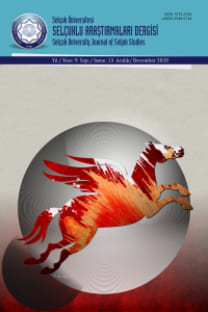ÇİFT BAŞLI KARTAL ve SELÇUKLULAR
Mezopotamya, Mısır, Anadolu, İran hatta Amerika ve Uzak Doğu’da kurulmuş eski çağ medeniyetlerinden itibaren birçok devlette tesadüf edilen çift başlı kartal sembolü, dünyanın en eski ikonografik öğelerinden biridir. Bu ikonografik öğenin, tarih boyunca farklı coğrafyalarda kurulan, farklı etnik, dinî ve sosyo-kültürel yapıya sahip toplumlar tarafından benimsenmesi ve gerek devlet hayatında gerekse sosyo-kültürel hayatta yer edinmiş olması dikkat çekicidir.Başta sanat tarihçileri olmak üzere farklı disiplinlere mensup araştırmacılar tarafından yapılan çalışmalar, çift başlı kartalın eski Türk inançları, Türk mitolojisi ve halk edebiyatında mevcut olan ikonografik bir öğe olduğunu ve bunun en belirgin örneklerinin Türkiye Selçukluları Devrine ait olduğu ortaya koymaktadır.Bu durum, söz konusu sembolün Türk tarihi bakımından önemi ve ifade ettiği anlam konusunda çeşitli çalışmaların yapılmasına, farklı görüşler ileri sürülmesine sebep olmuştur. Bu cümleden olmak üzere ortaya çıkan görüşlerin başında, çift başlı kartalın Selçukluların devlet sembolü olduğu iddiası gelmektedir.Bu çalışmada, Türkiye Selçuklu dönemine ait mimari eserlerde, sikkelerde ve sair sanat eserlerinde tesadüf edilen çift başlı kartal figürleri ve özellikle İbn Bîbî’nin meseleye mehaz teşkil eden kayıtlarından hareketle çift başlı kartalın Selçuklular dönemindeki anlamı ve devlet sembolü olarak nitelendirilip nitelendirilemeyeceği incelenecektir.
Anahtar Kelimeler:
Selçuklular, Türkiye Selçukluları, Hâkimiyet Alâmetleri, İkonografik Öğeler, Çift başlı kartal
DOUBLE-HEADED EAGLE AND SELJUKS
Beginning from the civilisations of ancient times, the symbol of “The double-headed eagle” is one of the oldest iconographical element which is seen in many states founded in Mesopotamia, Egypt, Anatolia, Iran and even in America and the Far East. It is noteworthy that this iconographical element had been adopted by the societies, having different ethnical, religious and socio-cultural structures, which were founded in different geographies and that it had taken place in socio-cultural life and in official institutions. In the studies made by the researchers belonging to different disciplines, art historians in particular, it reveals that “The double-headed eagle” is an iconographical element that is present in early Turkish beliefs, Turkish mythology and folk literature and that the Sultanate of Rum had had the most evident examples of that element. That case caused various studies to be made about the meaning it expressed and the importance of that element in Turkish history. Besides, some different views were put forward about it. In this context, the first of those views was the argument that “The double-headed eagle” had been the state symbol of the Seljuks. In this study, it will be considered whether “The double-headed eagle” can be qualified as the the state symbol along with the meaning of it in the era of Seljuks, by inspecting the figures of double-headed eagle that were seen in buildings of the era of the Sultanate of Rum, coins and the other art works and by regarding the records of Ibn Bibi that constitute the source of the topic.
Keywords:
Seljuks, Seljuk Sultanate of Rum, symbols of sovereignty, iconographical elements, the double-headed eagle.,
- ISSN: 1015-2105
- Yayın Aralığı: Yılda 2 Sayı
- Başlangıç: 1986
- Yayıncı: Selçuk Üniversitesi
Sayıdaki Diğer Makaleler
IV. HAÇLI SEFERİNİN BALKANLARIN ETNİK YAPISINA ETKİLERİ
SELÇUKLUDAN GÜNÜMÜZE KONYA’DA HALICILIK ÖRNEĞİNDE BİR SELÇUKLU HALISINDA RENK ANALİZİ
COĞRAFİ PERSPEKTİFTEN MYRİOKEFALON SAVAŞI’NIN YERİ VE KONYA BAĞIRSAK BOĞAZI
ÇİFT BAŞLI KARTAL ve SELÇUKLULAR
KARATAY MEDRESESİ’NİN BİÇİMLENDİRİLMESİ VE MİMARİ ANLAM BOYUTU
SOVYETLER DÖNEMİ DERS KİTAPLARINDA ESKİÇAĞ TARİHİ VE ESKİ TÜRK TARİHİ’NİN ÖĞRETİMİ
MENGÜCEKLİ ASKERÎ SAVUNMA YAPILARINDAN BİRİSİ: DİVRİĞİ KALESİ
